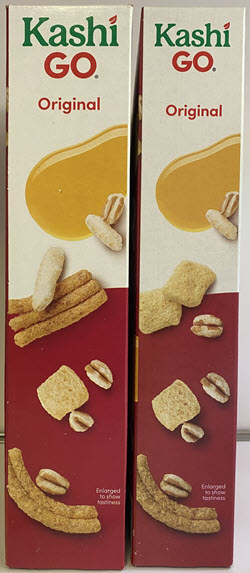Oh No, Not My Cereal Too!
June 16, 2024
My wife just refreshed our supply of Kashi Go Original, for years my favorite cereal.

Old versus New
We were disappointed to find that the box she brought home doesn’t even come close to measuring up to the previous one. Same name, same packaging, same height and width as the previous, but the new has one very noticeable difference. Looked at from the side, the new box has only about two-thirds the bulk of the old.
It turns out the new contains 9.7 ounces of cereal, versus 13.1 in the old. The new box discloses that it contains four servings of cereal. The old held six. Those amount to big servings but the proportionality would be the same at any size.
It means that I and every other Kashi Go lover will now be paying 50 percent more for the same number of breakfast servings than we did just weeks ago.
The opportunistic, one might say greedy, souls at WK Kellogg Co. have made my favorite cereal into a poster child for shrinkflation. The price doesn’t go up. The size goes down. And it doesn’t factor at all into the calculations of inflation.
A box of cereal is just one item in the market basket but multiply that experience across the grocery store and one can begin to understand why many say they are struggling. It’s a perfect illustration of last week’s report on Why Economic Woe Won’t Go Away. For those who haven’t done so already, please take a few minutes to give it a read.
Kashi Go isn’t the first or only cereal offender. Sen. Bob Casey, the Democrat running for re-election in Pennsylvania, has trashed the entire industry in a television spot named “Shrinky Dink” that depicts CEO’s sneaking into a grocery store to trade out cereal boxes with smaller replacements. Casey is ready to do battle.
By comparison, President Biden remains something of a reluctant warrior. In a new ad, he assures Americans that he feels our pain, saying he’s fighting to lower costs for food and rent. He stops short though of calling out the many companies, the makers of Kashi Go being but one example, that are propping up profits at the expense of consumers.
This additional levy is borne by everyone, but the biggest effect is on those who can afford it the least.
— Richard Gilman

What is your favorite cereal? It happens that cereal is about one of the cheapest food groups there is. I was talking to my niece yesterday who works at the Albany, NY airport. She told me many of those she works with have two minimum wage jobs. My godson works two jobs so he can support his family. It is outrageous that anyone thinks the economy is good! Tell that to those who are supporting a family or those on a small fixed income. People are deciding do I buy food and skip some bills? We are not talking about a small number of our population as your article points out.
The question is, what are we the citizens of this country going to do about it?
Based on the comments to the Our Common Purpose poll, I agree completely. Those of us in better circumstances don’t have the foggiest appreciation of what it looks or feels like to work two minimum wage jobs just to get by.
Thanks for this post, Richard. Your example of Kashi Go is representative of what is happening across the food industry. And the two points you make are on target: that this reduction is missed in the economic data and that lower income people are affected the most. The rest of us see the economy as appearing to improve while barely noticing the greediness of the major corporations, their leaders, and their stockholders. I hope if any readers missed last week’s report that they will go back and read it now. It is a good explanation of why many still say inflation will be a factor in their vote. It’s time for the Democrats, led by Biden, to call out this downsizing of food packaging.. It happens elsewhere, but in the food industry it hits the most people.